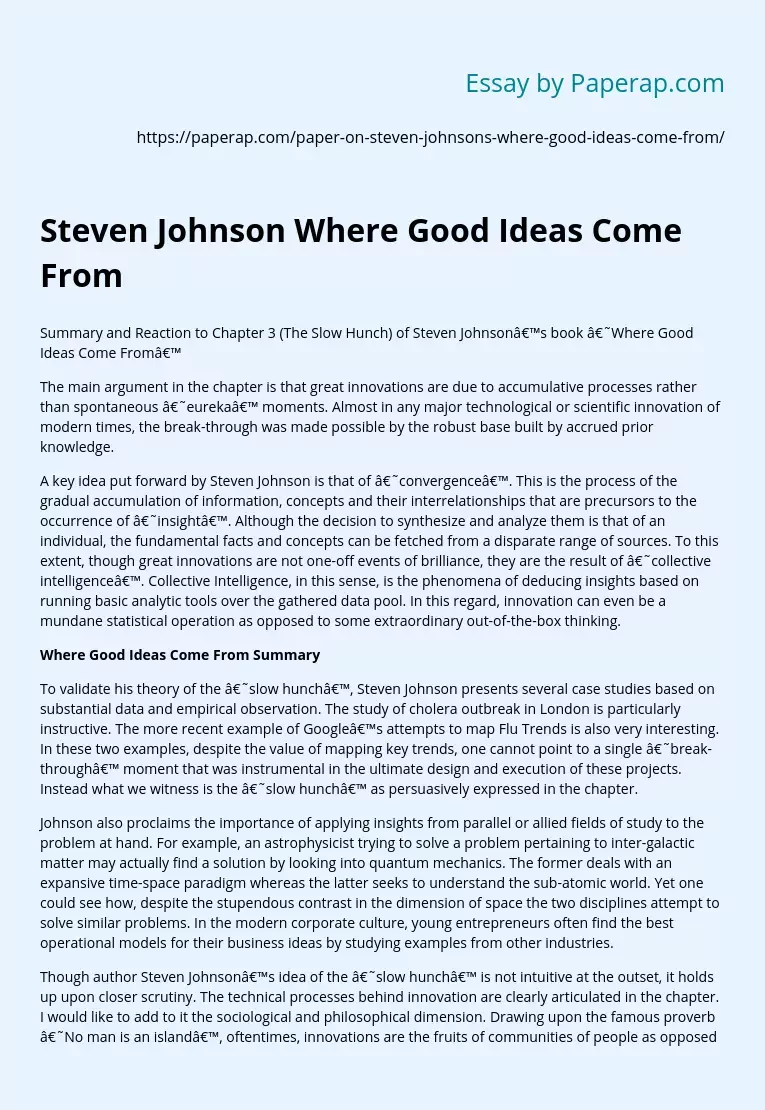Steven Johnson Where Good Ideas Come From
Summary and Reaction to Chapter 3 (The Slow Hunch) of Steven Johnson’s book ‘Where Good Ideas Come From’
The main argument in the chapter is that great innovations are due to accumulative processes rather than spontaneous ‘eureka’ moments. Almost in any major technological or scientific innovation of modern times, the break-through was made possible by the robust base built by accrued prior knowledge.
A key idea put forward by Steven Johnson is that of ‘convergence’. This is the process of the gradual accumulation of information, concepts and their interrelationships that are precursors to the occurrence of ‘insight’.
Although the decision to synthesize and analyze them is that of an individual, the fundamental facts and concepts can be fetched from a disparate range of sources. To this extent, though great innovations are not one-off events of brilliance, they are the result of ‘collective intelligence’. Collective Intelligence, in this sense, is the phenomena of deducing insights based on running basic analytic tools over the gathered data pool.
In this regard, innovation can even be a mundane statistical operation as opposed to some extraordinary out-of-the-box thinking.
Where Good Ideas Come From Summary
To validate his theory of the ‘slow hunch’, Steven Johnson presents several case studies based on substantial data and empirical observation. The study of cholera outbreak in London is particularly instructive. The more recent example of Google’s attempts to map Flu Trends is also very interesting. In these two examples, despite the value of mapping key trends, one cannot point to a single ‘break-through’ moment that was instrumental in the ultimate design and execution of these projects.
Instead what we witness is the ‘slow hunch’ as persuasively expressed in the chapter.
Johnson also proclaims the importance of applying insights from parallel or allied fields of study to the problem at hand. For example, an astrophysicist trying to solve a problem pertaining to inter-galactic matter may actually find a solution by looking into quantum mechanics. The former deals with an expansive time-space paradigm whereas the latter seeks to understand the sub-atomic world. Yet one could see how, despite the stupendous contrast in the dimension of space the two disciplines attempt to solve similar problems. In the modern corporate culture, young entrepreneurs often find the best operational models for their business ideas by studying examples from other industries.
Though author Steven Johnson’s idea of the ‘slow hunch’ is not intuitive at the outset, it holds up upon closer scrutiny. The technical processes behind innovation are clearly articulated in the chapter. I would like to add to it the sociological and philosophical dimension. Drawing upon the famous proverb ‘No man is an island’, oftentimes, innovations are the fruits of communities of people as opposed to one individual. The acknowledged innovator is only the beneficiary of all the ground work done by numerous predecessors. Although the latter group does not get the claim of ownership or patent to the idea, their vital role is lucidly illustrated by Steven Johnson. I find this to be an important message for the society at large, for, far too often, individual egoism overwhelms the primacy of the community. If only we understand the interconnectedness among individuals, strife and conflict would be substantially reduced in modern societies.
Reference:
Steven Johnson, The Slow Hunch, Chapter 3, Where Good Ideas Come From: The Natural History of Innovation, ISBN 978-1-59448-771-2, published in 2010.
Summary and Reaction to Chapter 3 (The Slow Hunch) of Steven Johnson’s book ‘Where Good Ideas Come From’
The main argument in the chapter is that great innovations are due to accumulative processes rather than spontaneous ‘eureka’ moments. Almost in any major technological or scientific innovation of modern times, the break-through was made possible by the robust base built by accrued prior knowledge.
A key idea put forward by Steven Johnson is that of ‘convergence’. This is the process of the gradual accumulation of information, concepts and their interrelationships that are precursors to the occurrence of ‘insight’. Although the decision to synthesize and analyze them is that of an individual, the fundamental facts and concepts can be fetched from a disparate range of sources. To this extent, though great innovations are not one-off events of brilliance, they are the result of ‘collective intelligence’. Collective .
Steven Johnson Where Good Ideas Come From. (2019, Dec 05). Retrieved from https://paperap.com/paper-on-steven-johnsons-where-good-ideas-come-from/

